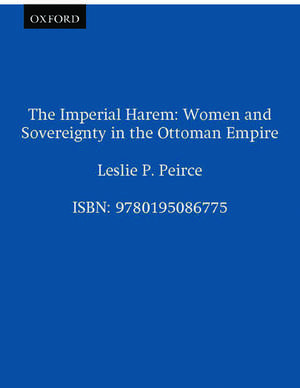The Imperial Harem: Women and Sovereignty in the Ottoman Empire: Studies in Middle Eastern History
Leslie P. Peirceen Limba Engleză Paperback – 28 iul 1994
Din seria Studies in Middle Eastern History
- 31%
 Preț: 948.01 lei
Preț: 948.01 lei - 7%
 Preț: 126.28 lei
Preț: 126.28 lei - 30%
 Preț: 952.96 lei
Preț: 952.96 lei - 31%
 Preț: 950.87 lei
Preț: 950.87 lei - 18%
 Preț: 324.87 lei
Preț: 324.87 lei - 34%
 Preț: 693.29 lei
Preț: 693.29 lei - 22%
 Preț: 202.66 lei
Preț: 202.66 lei - 30%
 Preț: 531.96 lei
Preț: 531.96 lei - 21%
 Preț: 527.58 lei
Preț: 527.58 lei - 34%
 Preț: 536.16 lei
Preț: 536.16 lei - 50%
 Preț: 809.38 lei
Preț: 809.38 lei - 31%
 Preț: 887.43 lei
Preț: 887.43 lei - 31%
 Preț: 861.39 lei
Preț: 861.39 lei - 30%
 Preț: 570.83 lei
Preț: 570.83 lei - 28%
 Preț: 466.20 lei
Preț: 466.20 lei - 31%
 Preț: 921.06 lei
Preț: 921.06 lei - 19%
 Preț: 373.33 lei
Preț: 373.33 lei - 31%
 Preț: 873.88 lei
Preț: 873.88 lei - 28%
 Preț: 328.24 lei
Preț: 328.24 lei - 13%
 Preț: 270.45 lei
Preț: 270.45 lei
Preț: 383.89 lei
Preț vechi: 494.31 lei
-22% Nou
Puncte Express: 576
Preț estimativ în valută:
73.47€ • 79.77$ • 61.71£
73.47€ • 79.77$ • 61.71£
Carte tipărită la comandă
Livrare economică 12-18 aprilie
Preluare comenzi: 021 569.72.76
Specificații
ISBN-13: 9780195086775
ISBN-10: 0195086775
Pagini: 400
Ilustrații: halftones, maps
Dimensiuni: 156 x 234 x 18 mm
Greutate: 0.55 kg
Ediția:Revised
Editura: Oxford University Press
Colecția OUP USA
Seria Studies in Middle Eastern History
Locul publicării:New York, United States
ISBN-10: 0195086775
Pagini: 400
Ilustrații: halftones, maps
Dimensiuni: 156 x 234 x 18 mm
Greutate: 0.55 kg
Ediția:Revised
Editura: Oxford University Press
Colecția OUP USA
Seria Studies in Middle Eastern History
Locul publicării:New York, United States
Recenzii
It is a well-informed, scholarly study which owes little to the contemporary Ottoman political theory which normally dominates the historiography of this period, and a good deal to sociological insight. Although much of Peirce's material and many of her individual points are not in themselves new, her overall approach is. The book is striking and refreshing for its consistent and detailed re-interpretation of a very large subject, examining the nature of Ottoman sovereignty in terms of the dynastic family as a whole rather than merely of the sultan who was its figurehead.









